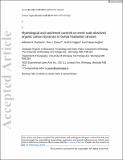| dc.contributor.author | Ducharme, Adrienne A. | |
| dc.contributor.author | Casson, Nora J. | |
| dc.contributor.author | Higgins, Scott N. | |
| dc.contributor.author | Friesen-Hughes, Karl | |
| dc.date | info:eu-repo/date/embargoEnd/2022-06-23 | en_US |
| dc.date.accessioned | 2021-06-25T16:49:01Z | |
| dc.date.available | 2021-06-25T16:49:01Z | |
| dc.date.issued | 2021-06-23 | |
| dc.identifier.citation | Ducharme, Adrienne A. Nora J. Casson, Scott N. Higgins, and Karl Friesen-Hughes. "Hydrological and catchment controls on event-scale dissolved organic carbon dynamics in boreal headwater streams." Hydrological Processes, accepted article. DOI: 10.1002/hyp.14279. | en_US |
| dc.identifier.issn | 0885-6087 | |
| dc.identifier.uri | https://hdl.handle.net/10680/1954 | |
| dc.description | Accepted version of manuscript. | en_US |
| dc.description.abstract | Hydrological events transport large proportions of annual or seasonal dissolved organic carbon (DOC) loads from catchments to streams. The timing, magnitude and intensity of these events are very sensitive to changes in temperature and precipitation patterns, particularly across the boreal region where snowpacks are declining and summer droughts are increasing. It is important to understand how landscape characteristics modulate event-scale DOC dynamics in order to scale up predictions from sites across regions, and to understand how climatic changes will influence DOC dynamics across the boreal forest. The goal of this study was to assess variability in DOC concentrations in boreal headwater streams across catchments with varying physiographic characteristics (e.g. size, proportion of wetland) during a range of hydrological events (e.g. spring snowmelt, summer/fall storm events). From 2016 to 2017, continuous discharge and sub-daily chemistry grab samples were collected from three adjacent study catchments located at the International Institute for Sustainable Development – Experimental Lakes Area in northwestern Ontario, Canada. Catchment differences were more apparent in summer and fall events and less apparent during early spring melt events. Hysteresis analysis suggested that DOC sources were proximal to the stream for all events at a catchment dominated by a large wetland near the outlet, but distal from the stream at the catchments that lacked significant wetland coverage during the summer and fall. Wetland coverage also influenced responses of DOC export to antecedent moisture; at the wetland-dominated catchment, there were consistent negative relationships between DOC concentrations and antecedent moisture, while at the catchments without large wetlands, the relationships were positive or not significant. These results emphasize the utility of sub-daily sampling for inferring catchment DOC transport processes, and the importance of considering catchment-specific factors when predicting event-scale DOC behaviour. | en_US |
| dc.description.uri | https://onlinelibrary.wiley.com/doi/10.1002/hyp.14279?af=R | en_US |
| dc.language.iso | en | en_US |
| dc.publisher | Wiley | en_US |
| dc.rights | info:eu-repo/semantics/openAccess | en_US |
| dc.subject | Dissolved organic carbon | en_US |
| dc.subject | Hysteresis | en_US |
| dc.subject | Storm events | en_US |
| dc.subject | Snowmelt | en_US |
| dc.subject | Solute exports | en_US |
| dc.subject | Climate change | en_US |
| dc.subject | Boreal forests | en_US |
| dc.subject | Antecedent moisture | en_US |
| dc.title | Hydrological and catchment controls on event-scale dissolved organic carbon dynamics in boreal headwater streams | en_US |
| dc.type | Article | en_US |
| dc.identifier.doi | https://doi.org/10.1002/hyp.14279 | en_US |

